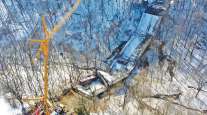Oversize-Load Permit for I-5 Bridge Didn’t Guarantee Height Clearances
This story appears in the June 24 print edition of Transport Topics.
Hours before the oversize load being carried on a flatbed truck hit a bridge truss on Interstate 5 in Washington state and caused part of the bridge to collapse May 23, Mullen Trucking received a permit to haul the 15-foot, 9-inch tall load, according to investigators.
But the permit, which the Washington State Department of Transportation posted on its website, had a disclaimer trucking officials said is common: “Route does not guarantee height clearances.”
Carriers in Washington always are responsible for confirming clearances, WSDOT spokesman Travis Phelps said, and other states have similar policies.
“Every state does it a little differently, but all states hold the carrier responsible for any striking of overhead objects,” said Michael Card, president of Combined Transport Inc. in Central Point, Ore.
Some states provide carriers with routes they believe will accommodate the oversize loads, while others allow carriers to choose their own routes, Card said. But routes are not guaranteed, and it is ultimately the carrier’s responsibility to ensure proper clearances.
“I’ve seen some states that will route you on their routes, saying, ‘This height is correct,’ and we’ve come across structures that are too low,” said Card, who also is chairman of American Trucking Associations.
That leaves fleets to determine routing themselves, using a combination of data provided by states or private companies, pre-trip surveys, pilot vehicles in front of the trucks with poles attached at the height of the load, and knowledge of the routes. But nothing is perfect.
“You really have to just have knowledge of what you’re doing, knowledge of what you’ve done in the past, and a good driver that has done oversize before, who you can trust with it,” said Dana Bibb, truck operations manager for Mercer Transportation Co. in Louisville, Ky.
Mercer relies heavily on pre-trip surveys and the routes of previous trips it has taken, in addition to pilot cars, which are required for certain loads, Bibb said. But that is not foolproof, especially because highway repaving can raise roads by a few inches.
“So much of it is trial and error,” she said. “Hopefully, there’s not much error.”
The Mullen truck that caused the bridge collapse, investigators say, was escorted by a pilot car with a pole raised to a level higher than the load, the National Transportation Safety Board said. The pilot car’s driver told NTSB the pole did not hit anything on the bridge.
NTSB said the Mullen driver felt “crowded” by another tractor-trailer passing his vehicle on the left. That caused the Mullen driver to steer to the right. The truck’s load allegedly hit the truss structure, causing a span to collapse into the river below. The truck made it off the bridge but two passenger vehicles fell into the river. Everyone was rescued.
Navigation software and systems usually can route trucks away from extremely low clearances. But for higher clearances, there are no reliable navigation systems, Card said.
“If there is one, have them call me, because we’ll buy it,” he said.
“I haven’t found one yet,” Bibb said. “If I found one that was reliable, I’d be thrilled to death.”
Clearance issues are difficult for pilot car drivers as well, said Wayne Major, an independent pilot car driver based in Canton, N.Y. Pilot cars are not foolproof and the clearance data that would make the process easier is not available.
“I don’t think there’s enough information let out to the pilot car drivers. I think it should be done by the state,” Major said.
States providing permits might check the road’s clearances only against the state’s own database. “They do it by computer, but they don’t realize that the county has started construction on that area,” he said.
While the trucking company is held accountable for any objects that are struck, pilot car drivers can be sued by the carriers for their negligence as well, Major said. He carries $1 million in liability insurance for that reason.
Surveying an entire route before a trip can be expensive, but it’s probably the best way to ensure clearances, in addition to using a pilot vehicle on the trip, said Steven Todd, director of advocacy for the Specialized Carriers & Rigging Association.
“We still stress the old-fashioned best advice: When possible, run your own route surveys, with your own height survey, prior to your move,” he said. “Even when a state doesn’t require them to run with a pilot car, many of our members run with one anyway, and we encourage that.”
SC&RA recommends that trucks with oversize loads communicate often with their pilot vehicles, Todd said. The vehicles should be far enough apart that the truck can stop if the pilot vehicle’s pole hits something, or if there is another issue.
Some states have data available about clearances, but that information only should be used in combination with other precautions, Todd said.




